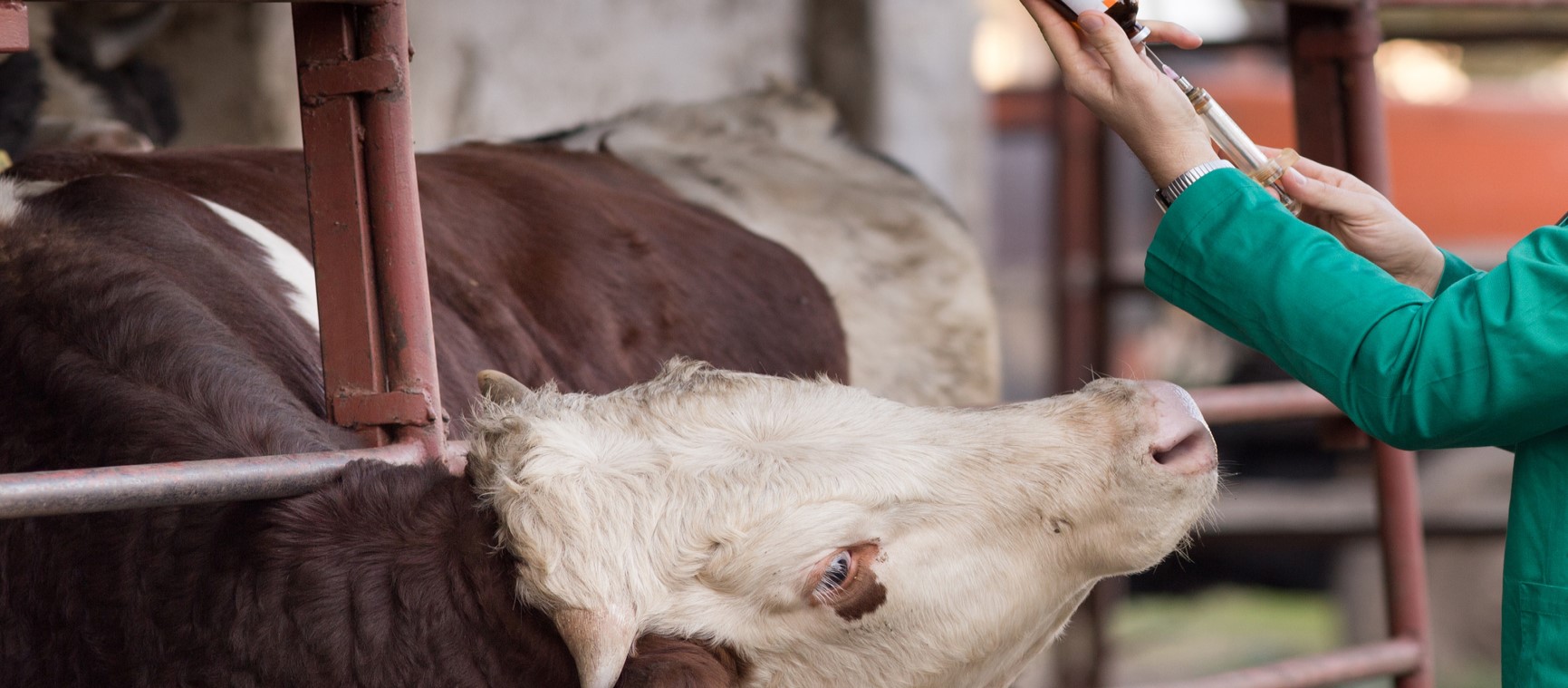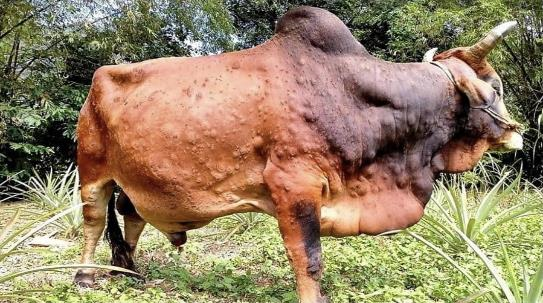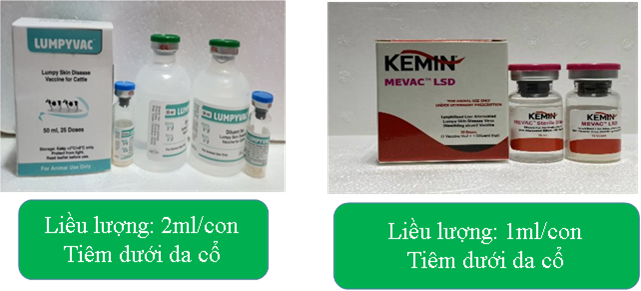RELATED TO THE LUMPY SKIN DISEASE IN CATTLE

 History - characteristics of the disease
History - characteristics of the diseaseLumpy skin disease is a infectious disease that affects cattle caused by a virus of the family Poxviridae, genus Capripoxvirus (sharing the same genus with the virus that causes Chickenpox in goats and sheep).
In 1929, the disease was first discovered in Zambia.
October 2020 in Lang Son province, Vietnam.
The incubation period is about 4-14 days.
The disease spreads very quickly with the mortality rate of about 1-5%.
Does not affect humans.
Transmission: through placenta, semen, arthropods, transport, direct contact.
Infected cattle: Significant decrease in milk production and fertility, miscarriage, skin lesions, weight loss, reduced meat quality, mortality.
 Causes of the disease
Causes of the diseaseLumpy skin disease (LSD) is caused by Lumpy skin disease virus (LSDV), a virus of the family Poxviridae, genus Capripoxvirus.

1. CHARACTERISTICS OF THE VIRUS
- Does not affect humans
- Can be killed at 55 degrees Celsius in 2 hours or at 65 degrees Celsius in 30 minutes
- Sensitive to alkaline or acidic pH environments.
- Affects cattle the most easily, especially cows.
- Transmissed by Arthropods.


2. TRANSMISSION ROUTES
- Direct contact
- Blood-sucking insects like flies, mosquitoes, or Ixodoidea.
- Feed, water, tools carrying disease
- Transplacental transmission
- Calves having breastfeeding can become infected through milk or from lesions on the udders
- Syringes used in treatment and vaccination
- Natural or artificial mating
– Specimen: Skin nodules, scales, and scabs contain a relatively large number of LSD viruses. Viruses separated from this specimen can survive for up to 35 days and even longer.
– Blood :The LSD viruses can be separated from blood, saliva, eye and nasal secretions, and semen.
⇒ LSD viruses are found in the blood intermittently from about 7 to 21 days after infection and at a lower concentration than those in skin nodules
3. DIAGNOSIS:
a. Mortality rate:
- The mortality rate is usually low 1-5%
- In case of epidemic, the mortality rate can reach from 20-80%
- Can affect cows of all ages.
- Lactating cows and calves have more severe complications than grownup beef cattle
b. Clinical signs:
- Signs of LSD range from vague to severe ones. There was no evidence of virulence variation associated with different LSD strains.
- Fever caused by the infection but not obvious (maybe above 41 degrees C)
- Nodules and lumps of 2-5cm in diameter develop rapidly all over the body.
- Emerging round firm nodules commonly found on the head, neck, breasts, buttocks
c. Secondary symptoms:
- Rhinitis, conjunctivitis and excessive saliva secretion
- Swelling of superficial lymph nodes (shoulder, thighs, groins)
- Reduced milk production and weight loss
- Fatigue, anorexia, and emaciation
 Treatment - handling of infected cattle
Treatment - handling of infected cattle1. TREATMENT PRINCIPLES – INCREASING RESISTANCE – PREVENTING SUPERINFECTION
- Do not buy, sell, or exchange the cattle that are infected or suspected to be infected.
- Isolate the cattle that are infected or suspected to be infected.
- Clean and dry the barn. Disinfect the barn with TH4 or Verkon-S, etc.
- Disinfect the bodies of the cattle by spraying Iodin 3-5% once to twice per day.
- Use medicines that treat inflammation, release fever, and increase resistance.
- Treat sores with some medicines that can absorb water and stay in the sores for a long time (Rivanol, oxytetracyclin, intra repiderma, etc.), kill flies, etc.

2. PREVENTING SUPERINFECTION WITH ANTIBIOTICS
- Add Interferon to the medication to increase the effectiveness of treatment
- Apply high-dose antibiotics (Amox LA, PenStrep LA, Ceftiofur, etc.) for 3-5 days or 2-3 injections to prevent superinfection.
- Release heat with Paracetamol, Anagin C.
- Treat inflammation with Dexamethazone (not for pregnant cattle), Ketophen, Diclophenax, Flunixine, etc.
- Supportive infusion: Lactac ringer, 10-30% hypertonic sugar, 0.9% physiological saline. Add Catosal, Biotosal, Vitamin A, D, E, B12 into the infusion solution.
⇒ Cattle recover well with good nursery and care.
3. SOME MEDICINES FOR REFERENCE

 Prevention of the disease
Prevention of the disease- Conduct periodical spray disinfection in the barn
- PVDNC bao gồm ether (20%), chloroform, formalin (1%), phenol (2% trong 15 phút), sodium hypochlorite (2 – 3%), hợp chất iodine (pha loãng 1:33), Virkon (2%), hợp chất amoni bậc bốn (0,5%) và một số chất tẩy rửa như sodium dodecyl sulphate. Regularly (1-2 times/week) spray: Chemicals used to kill VDNC virus including ether (20%), chloroform, formalin (1%), phenol (2% in 15 years) min), sodium hypochlorite (2-3%), iodine compounds (1:33 dilution), Virkon (2%), quaternary ammonium compounds (0.5%) and some cleaning agents like sodium dodecyl sulphate.
- Clear bushes, kill insects, flies, mosquitos, etc.
- Avoid trading and shipping cattle between regions during the pandemic.
- Destroy dead infected cattle, don't buy and sell infected cattle to avoid spreading pathogens.
- Conduct vaccination.
1. PREVENTING THE DISEASE WITH VACCINE
Vaccination procedure
- All cattle including grownup, young, and pregnant ones must be vaccinated.
- Calves delivered by the cattle that have been vaccinated or naturally infected should be vaccinated at the age of 5-6 months or in the incoming vaccination
- Unvaccinated calves can be vaccinated at the age of 1-2 months (if there is a pandemic or a threat of pandemic)
- In case it is required to transport cattle, they should be vaccinated 28 days before the transportation
- Newly purchased cattle need to be vaccinated 28 days before entering the herd
- Buffalo can be vaccinated with the same dose and injection method as cows
Note: handling allergic cattle after vaccination
- Any vaccine can cause an allergic reaction after the injection. Therefore, any farm needs to prepare some medicines to handle the allergy.
- Signs of the allergy in cattle after vaccination: difficult breathing, red and swollen mucous membranes (eyes/nose), strong vibrations of muscles, erecting hairs, neurological manifestations (bellows, screams, struggles, etc.), foaming, etc.
- Emergency treatment: Move the cow to a cool place to increase breathing and heart rate. Adrenaline (Epinephrine) can be injected in combination with infusion (with additional supplements).
- In addition, after vaccination, cattle may have systemic reactions such as: high fever, loss of appetite, fatigue, etc. Antibiotics and anti-inflammatory medicines can be used in combination with injections to strengthen health.
2. VACCINATION
2 vaccines preventing LSD




